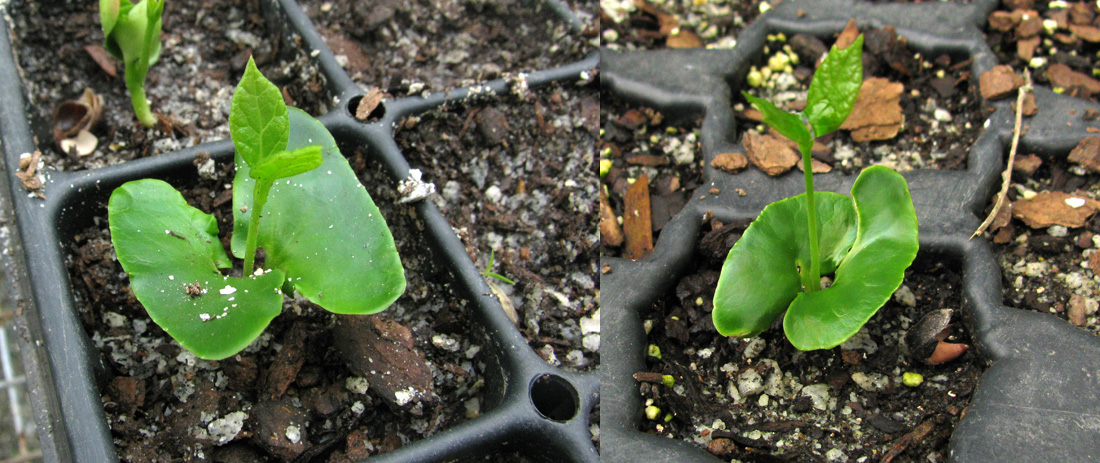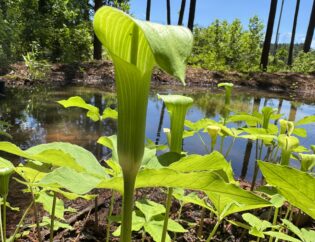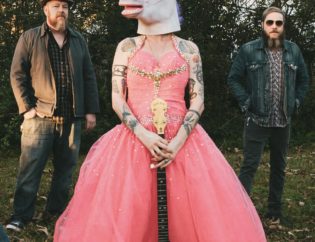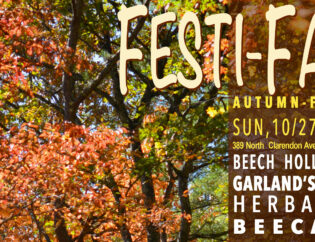
The flowers of Sweetshrub (Calycanthus floridus) are in full bloom right now. They are a deep maroon color that contrasts nicely with the bright, glossy green of the foliage. Some plants have more fragrant blooms than others, but if you can find an aromatic one do yourself a favor and take in the smell. Kind of like strawberries mixed with bananas and a little cinnamon or clove tossed in: there are not many fragrances like it. The overripe fruits of Sweetshrub’s cousin, Paw paw (Asimina triloba) are the closest scent that comes to mind. Sweetshrub flowers are unique in appearance as well with their spidery tepals wrapped around a central cluster of anthers. They look like they haven’t quite opened yet. The color, structure and smell of these flowers differ from most of the flowers that are familiar to us today because they are the results of adaptive strategies first developed over 100 million years ago.
Fossils from Brazil that date to the Cretaceous period (115 million years ago) have shown us the form of an ancestor of Sweetshrub named Araripia. The fossil “comprises flowers, buds, and leaves, and exhibits features that suggest that “among the Calycanthaceae, especially flowers of Calycanthus are most similar to the flower of Araripia” The Earth was a much different place 115 MYA to say the least: Only two massive continents, Gondwana and Laurasia, existed and the climate was much warmer and humid. Dinosaurs roamed the land and insects of all sizes occupied every niche in the dense tropical forests that covered the entire planet. Plants and insects were just beginning to respond to one another’s adaptive strategies. These responses were the first steps on a co-evolutionary path that would lead to very complex and specialized forms and life patterns on both sides of the aisle. Sweetshrub is a living relic from a time before bees when plants were just “learning” that insects could be used to facilitate cross pollination if they are given a little incentive.
This cutaway picture of a Calycanthus bloom shows the minimal differentiation of flower parts as one passes from outer to inner bloom. Instead of two separate parts, sepals and petals, there are tepals (a half-way-between-the-two structure more commonly found in monocots) surrounding and enclosing the anthers and ovary. The pollen producing anthers are very similar in their shape and arrangement to the tepals and very simple in form. The size is really the only variant in the form of the floral parts; There isn’t a lot of specialization. There are no nectar bearing parts to appeal to bees and butterflies because this flower form evolved before they did. Beetles were the most likely insects to transfer pollen between flowers as they ate it, so they are meant to appeal to beetles.
Attracting a beetle to a flower is not the same as attracting a bee or butterfly. First, there are the visual cues. Beetles, like moths, are attracted to bright white flowers, such as a Magnolia flower (also ancient and beetle pollinated), that reflects light well, especially at night. Some beetles are also attracted to deep reddish-brown colors, as several other plants known to be pollinated by flies and carrion feeding beetles such as Pawpaw (Asimina spp.), Carrion Flowers (Stapelia spp.) and Pipevine (Aristilochia spp.) have adopted a similar color scheme; Possibly to mimic wounded or rotting flesh. Second, there are olfactory cues. Many beetles evolved to feed upon the carcasses of other animals or their excrement. An appealing odor to a beetle is not necessarily the sweet smells that we humans most often associate with flowers or fruits. A spicy, earthy aroma that suggests some sort of decay is more likely to attract a bunch of beetles. Third, there is the form of the flower itself. Very simple, no complicated pollen sacs or parts that mimic female insects like orchids; no separate disk and ray flowers like asters, just the tepals in a semi-enclosed arrangement around the pollen bearing anthers and ovary. Beetles aren’t there for the sweet carbohydrate nectar, they just want the protein rich pollen. In the process of eating, they get covered in pollen grains that will be transferred to the next flower they feast upon. Mass appeal with vaguely appetizing aromas and easily accessible flowers were the beginnings of plant-pollinator relationships that grew more specific and specialized over the ensuing 115 million years to give us the biodiversity we see today.

Sweetshrub has been a popular cultivated shrub in the south since Europeans arrived, and continues to do well in the nursery trade to this day. I don’t think that many people, even among those that plant it and enjoy it, are aware of its ancient lineage.
Post Script/Cultivation Note:
The seeds of Sweetshrub are large, easy to collect and fun to grow. They also demonstrate a unique and probably ancient strategy of having no energy reserves stored in the seed. It’s just the seed leaves (cotelydons) wound tightly in a spiral inside the seed coat waiting to unfurl and capture solar energy.

The relatively huge leaves quickly make up for the lack of stored reserves and the true leaves and stem shoot up through the middle of them.









